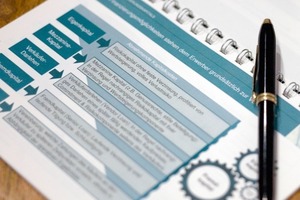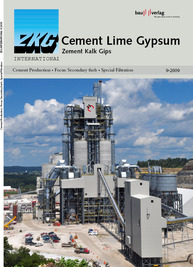Sale-and-Lease-back guarantees immediate solvency
This ground-breaking financing tool is becoming more and more popular, whereas not only companies affected
by the crisis can benefit.
Even though building investments might show results soon due to public investment programmes and manifold energetic recapitalisation efforts: after several successful years the building material industry has now been on a downward trend for months. While the demand for residential buildings has stabilised, the recession in the commercial construction sector is obvious. Furthermore, in their spring reports economic research institutes act on the assumption that the gross domestic product will decline by 6 % in 2009. A decline of 3 % is expected for this year on the domestic building investment sector and of even 10 % for commercial building investments! As a result, many companies have to think of other ways of raising money instead of bank credits or they use the opportunity to re-organise and optimise their finances by following the guidelines of modern company financing. The range of alternative financing tools is a broad one. Especially sale-and-lease-back is becoming more and more popular. To condemn this instrument as flogging the family silver is wrong: Sale-and-lease-back often is the only way for companies to realise the true market value of their assets; and in German medium-sized companies there is a billion Euro potential slumbering away – unexploited. Yet companies should decide carefully about for what they would like to use the obtained liquidity and must know about the consequences of these transactions. Rainer Wieser, financial expert with the independent Munich Corporate Financing Consulting Company Proventis GmbH, talks about what sale-and-lease-back really is, explains its pros and cons and what to keep in mind.
Wieser: First, a company sells its estates, machinery or other assets at their current market price to a leasing company. Then it rents or leases back the sold items again.
Wieser: For warranty reasons the sales agreement is always a sale-and-lease-back contract. The transfer – to which the seller commits through the sales agreement and which consists of the components agreement and transfer by default – looks like this: With movable goods as well as with estate property an agreement is made. With movable goods the actual transfer is replaced by a transfer substitute – to be precise a constructive possession of chattels based on agreement. With estate property, a public document and the land registry replace the transfer. This way the company is still in possession of these assets in both cases despite having sold them. Basically, the leasing contract is a surrender of use contract which regulates the financing volume, the contract duration as well as the compensation fee. A framework document connects sale-and-lease-back with the leasing contract.
With the full amortisation the lease provider’s total investment costs including his interest and administration expenses as well as his profit is covered by the fixed leasing payments. This is not the case with a partial amortisation, however; different contractual options are available in order to guarantee the required full amortisation of the costs when the contract expires .
Wieser: The particularly attractive point with sale-and-lease-back is that the seller gets a guarantee that allows him to use “his” object. Apart from that, sale-and-lease-back brings about an immediate release of funds – without increasing the debt ratio. Since especially with real estates and property, large funds are firmly bound to companies, this tool allows the release of high capital values. If an entrepreneur bought a property a long time ago at a reasonable price, for instance, he is not allowed to activate this property with its current market price within the German Commercial Code balance sheet. Through sale-and-lease-back, for instance, the real market price is realised. But also expensive machinery or IT systems bind large funds which usually cannot be invested in a profitable way. The free funds raised – visible as cash value in circulating assets within the balance sheet – can be used for instance for investments, innovations or debt redemptions. Thus, the company benefits from a greater degree of independence from banks and does not need to break through the bank lines. A special form of sale-and-lease-back which is being used more and more often is its deployment with self-made immaterial goods such as brands or patents. These assets are hardly accepted as securities by banks and are hence clear and free to be used within the scope of sale-and-lease-back financings. However, immaterial assets are very limited in the building material sector compared with other industries.
Generally speaking, with sale-and-lease-back the company gets the chance to buy back leased goods at some later point. If someone likes to keep his cards close to his chest he additionally benefits from the lack of transparency for third parties.
Wieser: Sale-and-lease-back always improves the ratings and thus the creditworthiness in cases where hidden reserves come to light, since assets have been increased through the selling. Apart from that, the equity return, an important figure for investors, is higher during the sales process through the profit made. One must not forget, however, that by selling, the assets are decreased within the balance sheet which in turn reduces securities for future outside creditors.
Wieser: Sale-and-lease-back yields tax benefits. Since the leasing costs can be declared as a loss for tax reasons which is not the case with loan repayments. This way the monthly leasing fee reduces the profit and as a result taxes. However, it is always necessary to keep in mind that taxes have to be paid on the profit made from sales.
Wieser: When activating hidden reserves it should, of course, be kept in mind that these options cannot be used again in the future and any financial issues will then have to be solved differently. Furthermore, after a sale-and-lease-back transaction the company is no longer the owner of the property and thus doesn’t participate in future increases of value, an exception being if there is a buying option connected with the sold property for its book value when the contract expires and the company makes use of that. Apart from that, an opinion needs to be furnished usually concerning the current value of the assets – a time and money consuming process!
Wieser: This form of fincancing should be employed when the released funds can be used in a profitable way since the company needs to make monthly payments. But also when money is urgently needed sale-and-lease-back can provide quick help. Other typical cases of deployment are the desire to activate hidden reserves in the balance sheet and to improve one’s rating and creditworthiness.



